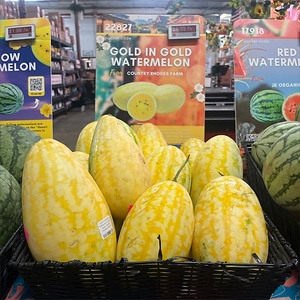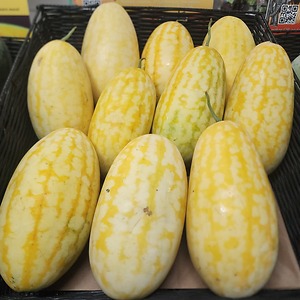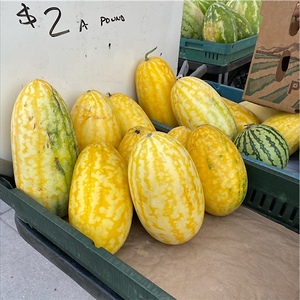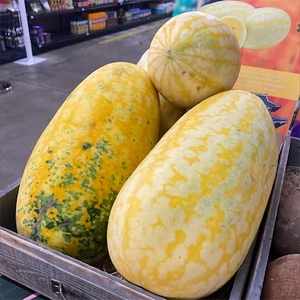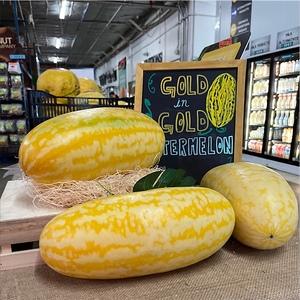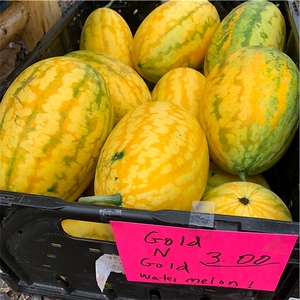


Gold in Gold Watermelons
Estimated Inventory, lb : 0
Description/Taste
Gold in Gold watermelons are medium to large sized and have an elongated oval shape. At full maturity, these melons can weigh anywhere from about 5,000 to 7,200 grams. Their thick, strong rind transitions from white to a creamy yellow with mottled gold stripes as they ripen. Slicing the melon in half reveals a white rind on the inside, surrounding vibrant golden-yellow flesh. This flesh is crispy and succulent, shiny from its juicy texture, and contains approximately 10 small teardrop-shaped black seeds. Gold in Gold watermelons have a fruity scent that grows stronger as they ripen. The fruit has a distinctly sweet taste with a higher sugar content than most red-fleshed varieties.
Seasons/Availability
Gold in Gold watermelons are available in the late summer and early fall months.
Current Facts
Gold in Gold watermelons are a hybrid species, botanically classified as Citrullus lanatus and part of the Cucurbitaceae family. They were named for their golden-striped skin and gold-hued flesh. This variety was declared the All-America Selections Edible-Vegetable Winner in 2017 for their flavor, yield, and disease resistance. Yellow-fleshed varieties are believed to have been cultivated in their native Africa around 5,000 years ago, predating the red-fleshed types that were a result of cross-breading. There are many yellow varieties aside from the Gold in Gold, including Desert King, Yellow Crimson, Buttercup, and Yellow Doll. Gold in Gold watermelons are considered picnic or icebox watermelons, which means that they are small enough to fit in an icebox and are good for sharing.
Nutritional Value
The nutritional value of Gold in Gold watermelons is not widely known. Yellow watermelons in general are a source of vitamins A and C, which support healthy vision and skin, cellular communication, immunity, iron absorption, collagen production, wound healing, and bone, teeth, cartilage, and reproductive health. They provide the body with potassium to help with electrolyte balance, muscle and nerve function, and blood pressure regulation. Yellow watermelon is a source of beta-carotene that protects against free radical cell damage and reduces the risk of age-related macular degeneration, cataracts, and UV ray skin damage. This fruit is made up of about 92% water, promoting hydration to those who consume it.
Applications
Gold in Gold watermelons are ideal for fresh eating and can be substituted for any variety of watermelon in recipes. When seared or grilled, marinated slices of Gold in Gold watermelon can be served alongside meat or fish. They can be pickled in a brine of vinegar, salt, chiles, and other spices. The pulp may be juiced for beverages, cold soups, vinaigrettes, ice cream, sorbet, and frozen margaritas. This variety may be cut into crinkle fries, turned into scoops with a melon baller, diced up for a fruit salad, or grated on top of a salad. Gold in Gold watermelons pair well with tomatoes, cucumbers, bitter greens, pineapple, coconut, feta and goat cheese, burrata, olive oil, citrus, mint, basil, serrano peppers, red pepper flakes, tajin, deviled eggs, bacon, rum, and tequila. Uncut Gold in Gold watermelons can be stored at room temperature for about a week. For longer storage, refrigerate for up to a month.
Ethnic/Cultural Info
Gold in Gold watermelons are a Korean hybrid created by the Asia Seed Company, a Seoul-based manufacturer developed in 1992. The company focuses on creating hybrids of various fruits and vegetables including broccoli, pepper, cabbage, radish, melon, cucumber, and watermelon. They export all across the world and devote many of their resources towards researching new ways to continue creating hybrids like the Gold in Gold watermelon that are functional, healthy, and resistant to disease and harsh weather.
Geography/History
Gold in Gold watermelons were developed by the Asia Seed Company in Korea. They were released to the market in 2017 and are available through select online seed vendors. This variety is a descendant of the original yellow watermelon that was first cultivated in Africa centuries ago. Gold in Gold watermelons grow in warm, dry climates with full sun exposure. They are a cultivated variety that is not found in the wild but may be grown commercially or in home gardens. They are sold in regions known for growing watermelons, such as Korea, Japan, and the United States, particularly in states like California, Texas, and Florida. Gold in Gold watermelons are typically found in select markets and specialty grocery stores.



